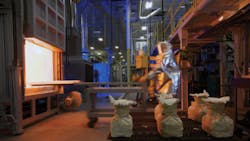Chromalloy will start producing nickel and cobalt master alloys at its investment casting foundry in Tampa next month, following installation of a new Consarc vacuum induction melter there. Melting and casting of ingots in those specialty alloys mainly will support the foundry’s production of aerospace and industrial gas turbine blades, vanes, and other components.
The decision to add master alloy production was made in 2012, according to Chromalloy vice president and general manager Dr. Mike Beffel, who explained the new capability is part of the operation’s “strategic growth and development.” Since the start-up of the 1-million-lb/year foundry in late 2010, Chromalloy expanded by adding a custom ceramic core manufacturing operation there.
Beffel said the new VIM furnace represents an investment of more than $10 million.
"Over the next 90 days we will meet the manufacturing requirements to commence production of master alloys for ingots used to manufacture gas turbine engine equipment," Chromalloy president Carlo Luzzatto said in a statement.
The vacuum induction melting (VIM) process is gaining wider use for production of high-performance and reactive materials. Melting is achieved by electromagnetic induction under vacuum in a refractory-lined chamber, with a series of pumps that allow the refined metal to be poured into molds under vacuum or inert gas. Because the alloys being produced are prone to oxidation or contamination, the VIM process makes it possible to remove dissolved or chemically bonded impurities, so the resulting alloys are homogenous for use as melt stock in subsequent foundry processes.
VIM furnaces mainly produce large ingots for remelting and small round bars (i.e., master alloys) for investment casting. Chromalloy said its master alloys might include rare earth metals used to stabilize base metals, and add greater corrosion resistance and strength at extreme temperatures.
Chromalloy will have capacity to produce up to 3 million lb./year of master alloys for its own downstream use, though it indicated it could supply master alloy ingots to other turbine component manufacturers, too. Beffel deflected an inquiry about supplying master alloys to Chromalloy’s Carson City, NV, foundry, but he noted the VIM may produce other alloys and steel ingots “based on demand from our customers.”
"Chromalloy master alloys will be produced to the specifications of our customers in the aerospace and energy industries," Luzzatto stated. "With this capability Chromalloy is fully positioned and vertically integrated, from master alloy to finished parts, to offer equipment manufacturers a complete range of nickel- and cobalt-based castings, in addition to the engineering services and part repairs we now offer."
About the Author
Robert Brooks
Content Director
Robert Brooks has been a business-to-business reporter, writer, editor, and columnist for more than 20 years, specializing in the primary metal and basic manufacturing industries. His work has covered a wide range of topics, including process technology, resource development, material selection, product design, workforce development, and industrial market strategies, among others.
